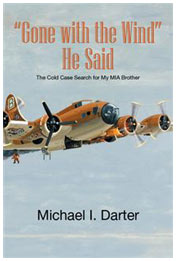
Moans went up from the crews when they heard that the target for the day was going to be Bremen, Germany. The men were quite anxious because they knew the area was deep into Germany, and it was surrounded by hundreds of anti-aircraft guns, as well as fighter bases that have taken a terrible toll on previous missions.
Orders were orders, so over 600 B-17 and B-24 bombers took off from their bases in England on the 16th of December 1943. Their targets were going to be the large submarine facilities in Bremen. Fighter support was also supposed to be there for the bombers.
Just three weeks prior, my brother’s aircraft, the “Lonesome Polecat II” B-17, was on a mission to Bremen and was torn to shreds by German fighters. Two crewmembers were killed during the encounter and the B-17 was hit with flak causing many holes. Amazingly, the severely damaged B-17 made it back to their Horham base thanks to the pilot, who put the Polecat into a steep dive and eluded the German fighters. Now weeks later they were heading back to that area.
The flight path into Germany went well but as the bombers approached Bremen at a distance, Lorren Dodson, the top turret gunner notice something menacing. As he was retelling the story to me, he said this, “Ahead of us was a huge black cloud such as I’ve never seen before or since. It was coal black, much darker than any thunder clouds. It seemed as if there was no limit to height or length of it. This was all coming from the anti-aircraft batteries on the ground.”
Lorren said that a few moments later there was a violent flax explosion under the aircraft and they went into a violent dive. My brother, Lee, and Schreiner were knocked down by concussion and pinned to the floor by centrifugal force of the spinning motion. Thankfully, the pilots, Delbern and Neff, managed to pull the plane out of the dive. However, by the time the crew realized what was happening, they have already dropped over a mile below the protection of the formation which was now only little specks high above the Polecat. The B-17 was now flying alone.
Despite all this, they were still on course and they managed to drop their bombs on the submarine facilities. Lorren said what followed was 15 minutes of pure hell. The #3 engine was damaged and on fire and throwing oil. The bomb bay doors were torn and buckled. The interphone system had been wrecked, and they were way below the formation and in enemy territory. This was the kiss of death because no American escort fighters were in sight!
Enemy fighter planes were suddenly sighted and all crew members were immediately back in their fighting positions. Charlie Schreiner said “The first Nazi attack came from the front and Eddie Woollen managed to knock down one. Eddie’s position was riddled by machinegun bullets.”
“In second attack, Loren Dodson in the top turret was knocked out cold by a 20 MM that exploded near-his face. A week later I met him in prison. He had two beautiful black eyes and was pretty scratched up. Also in this encounter #2 engine was damaged and on fire.”
“The third attack came from the rear at McKeegan’s position. Doral, Lee and I heard Mac’s guns open up and we all swung our guns toward the tail to give him our support and cover. In this pass, Darter, Lee, and I were knocked off our feet by exploding enemy machinegun fire. Darter was down for keeps.”
Pilot Delbern soon realized they were helpless and ordered bailout. Three up front crew heard the order and went out 15 minutes west of Bremen, all injured. They landed near Oldenburg & Leer, and became POWs for 18-months. Five other crewmembers in the rear of the aircraft weren’t so lucky. They never heard the bailout order due to the huge noise from all the guns firing and they were fighting for their lives as well.
After 15 minutes of pure HELL, attack after attack, the badly damaged and out of formation Polecat was about to be destroyed! “The enemy fighters made a wide circle to the rear. This time for the Kill!” said Charlie. “All the guns on the plane were chattering and we felt the impact of enemy bullets hitting our ship. McKeegan knocked two down, I got one, and Doral got a probable.”
But suddenly, a miracle occurred at 13:25 when the American escort of P-51 fighters appeared (this was the first combat mission of P51s to drive off the enemy fighters). The lives of the 7 crewmembers still on the bomber were spared, temporarily.
All was quiet…the crew in the rear of the aircraft scanned the sky for enemy aircraft, but they have disappeared. A miracle had occurred it seemed. They were wounded, but still alive!
